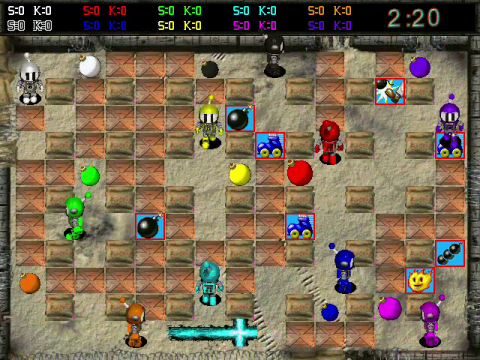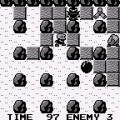- Bomberman Series Introduction / Bomberman (1983)
- 3-D Bomberman
- Bomberman (1985)
- RoboWarrior
- Atomic Punk
- Bomberman (1990)
- Atomic Punk (Arcade)
- Bomberman II
- New Atomic Punk: Global Quest
- Bomberman ’93
- Super Bomberman
- Hi-Ten Bomberman / Hi-Ten Chara Bomb
- Bomberman ’94 / Mega Bomberman
- Super Bomberman 2
- Super Bomberman 3
- Wario Blast: Featuring Bomberman
- Bomberman GB 2
- Bomberman: Panic Bomber
- Super Bomberman 4
- Saturn Bomberman
- Bomberman GB 3
- Bomberman B-Daman
- Super Bomberman 5
- Atomic Bomberman
- Neo Bomberman
- Amazing Bomberman
- Bomberman 64
- Saturn Bomberman Fight!!
- Pocket Bomberman
- Bomberman Fantasy Race
- Bomberman World
- Super Bomberman R
- Super Bomberman R Online
- Super Bomberman R2
Within the massive list of Bomberman games up until this point, it’s hard to get more unusual than Atomic Bomberman. As the first game in the franchise to be developed by an American company (Interplay Productions) and the first original title developed for computers, Atomic Bomberman channels trends and energy that are best described as “Extremely 90s”. As a result of its different origins, Atomic Bomberman makes many changes to the overall experience as well. The iconic protagonist is no longer the little white robot we’ve all come to love and has been replaced with multicolored robots that are much angrier and chattier. There’s no story at all and no other characters besides Bomberman show up. The visuals have been upgraded to 640×480 SVGA, making them crisper than any other 2D game up until this point, though the style still looks different from its previous games. Jun Chikuma and her wonderful musical stylings are obviously not present, but Atomic Bomberman does manage to beat Bomberman Hero to the punch with its use of drum and bass. Though it may be wildly different in many regards, this game successfully maintains the mechanical essentials of the Bomberman experience and can still provide solid multiplayer sessions even today.
Interplay licensed Bomberman from Hudson Soft out of a desire to create a more “modern” take on the franchise. This desire for modernization didn’t come from a lack of understanding what made the series fun to play in the first place, thankfully; in order to ensure the game lived up to the standards set by the franchise, Interplay specifically got the license to use Super Bomberman 3‘s code as the foundation for Atomic Bomberman. Though the mechanical identity was kept faithful, the changing of hands really comes into perspective with the overall tone of the game, for better or worse. Atomic Bomberman relies heavily on sassy one-liners and verbal jabs to fill the room with liveliness and this interesting choice in tone is likely going to deter some longtime fans. Mainstay items like the Power Glove and the Line Bomb have been renamed to things like “The Hand” and “The Spooge”, and a new item that causes multiple skull effects at once is called “Ebola”. You’ll regularly hear Bomberman call the player(s)a “stupid man’s idiot” or an amateur if a draw game happens and the Bombers destroy each other in a more gratuitous fashion. There are now 17 different animations that can play whenever a Bomberman is eliminated and there are various animations for whenever Bomberman is trapped by a bomb as well, giving the proceedings an entertaining new spin that can bring about unexpected surprises even several sessions in. It’s definitely jarring to see Bomberman pray for his life or stare in horror at the hole created in his chest as an opponent Bomberman sadistically giggles, but it all comes together to give Atomic Bomberman a truly distinct identity.
This game is perhaps most well-known for one particular bit of bizarre trivia. Bomberman is voiced by Charlie Adler and Billy West, who ham up their performances in the final game in an absurd but enjoyable way. Charlie Adler has a tremendously long list of voice acting credits in movies, animated TV shows, and games alike. Some examples of the range of his roles include Starscream in the Michael Bay Transformers movies, Cow and Chicken in the show of the same name, and Ignus in Planescape: Torment. Billy West is similarly prolific and is known for roles like Philip J. Fry in Futurama and voicing both Ren and Stimpy, and he even had a run on The Howard Stern Show, which makes this bit of trivia all the more fitting. Within the game’s files are a bunch of unused voice clips of the two actors saying things that are definitely NSFW and surely inappropriate for a Bomberman game. Some tamer voice clips went unused as well, but it’s the vulgar ones that get all of the attention, and rightfully so.
There’s no story to follow, but a clearly unfinished campaign mode does exist in the game’s files and can be accessed by pressing the C key multiple times on the player select screen. The campaign mode offers a series of essentially identical maps where you have to eliminate two enemy types (one of which looks almost identical to the ghosts from Pac-Man) as well as other Bombermen. Beyond a congratulatory pop-up message at the end, there’s little incentive to play through the “full” campaign, especially with how difficult the enemy Bomberman AI becomes.
If there’s one issue to be had with Atomic Bomberman in general, it’s that the AI is incredibly good no matter what mode you’re in. They’ll flawlessly dodge most of your bombs, seize any and all opportunities to trap you with a bomb, and remain aggressive in grabbing power-ups and pushing you to disadvantageous positions with nary a hitch in the execution of their strategy. Occasionally, they’ll flub and take themselves out, but it’s rare enough that you can’t bank on it happening when you want it to. They’re so good, in fact, that the AI struggles to fight itself! Putting multiple AIs in a round will pretty much guarantee that it goes to a draw game if you get eliminated because they’re so capable of dodging and anticipating each other’s moves. Fun can still be had by yourself, but this particular quirk makes playing with other humans highly preferable.
The game will feel immediately familiar to anyone who has played Super Bomberman 3, but it’s not an identical gameplay experience. Atomic Bomberman cranks up the speed significantly, so much so that the default speed level feels like what would be max speed in other games. Various features from Super Bomberman 3 didn’t make the cut, including Louies and revenge carts. In issue #27 of Next Generation magazine, project leader Jeremy Airey mentioned that there would be vehicles to replace the Louies (the magazine even has a render of what one of them looked like), but it seems that this idea was canned at some point in development. Despite the signs of various unimplemented features, Atomic Bomberman compensates for its lacking single player experience and missing multiplayer features in its own ways. Namely, up to 10 players can play at once, whether that’s with AI, online play, LAN, or on the same computer, making the multiplayer experience comparable to Saturn Bomberman with more flexibility in actually getting it set up. Customization is absolutely where Atomic Bomberman thrives and those willing to tinker will get the most out of it.
When it comes to default options, you can select a map layout based on the available scheme files, decide between free for all or team games, determine match duration, and you even get a say in how much of the arena will be closed off during Sudden Death. That’s pretty comprehensive on its own, but it gets better for those in the know. By holding Ctrl and pressing E multiple times, you can access a full-fledged level editor mode. With this mode, you can access dozens of pre-made schemes, manually place all the blocks yourself, and determine where each player starts. The item-related options are exceptionally in-depth and allow you to determine the percentage of blocks that have items in them, what items are and aren’t available, what items each player starts with, and the number of times an item can appear within soft blocks, whether that’s a hard number or a probability. All of these items’ values can be defined with numbers well beyond reason if you’d like, which can result in utterly absurd games where players drown the stage in dozens of bombs within the opening seconds. If you want to see the AI cower in fear from a lack of safe moves to make, this is the way to do it!
Though Atomic Bomberman was a one-time gig and Interplay never got to follow up on it, the game still has devoted fans interested in playing it. A fan remake of the game exists, which keeps the look and feel faithful while adding new features like USB device support, expanded OS compatibility, and online play that’s easier to set up. It also comes with a massive list of pre-made schemes, making it even easier to make every round feel different. Atomic Bomberman might have been a strange departure for the series, but it was also an endearing departure that still offered the core gameplay that fans wanted. This certainly isn’t the last time Bomberman will get weird, but those future divergences don’t always work out as cleanly as this one did.
Resources:
https://archive.org/details/NextGeneration27Mar1997/page/n49/mode/2up – A scan of issue #27 of Next Generation magazine
https://tcrf.net/Atomic_Bomberman – Unused elements in the game from The Cutting Room Floor, including a classic sprite for Bomberman
https://tcrf.net/Atomic_Bomberman/Unused_Voice_Clips – Samples of the unused safe for work and NSFW voice clips on The Cutting Room Floor
https://randomhoohaas.flyingomelette.com/bomb/pc-atom/site/atomic.html, https://randomhoohaas.flyingomelette.com/bomb/pc-atom/site/atomic2.htm – Backups of the Interplay website featuring alpha demos of the game
https://archive.org/details/atomicbombermanpostcards/2%20%281%29.JPG – A series of postcards that came with the game
https://www.goldencode.de/ – Page containing the fan remake for download (requires the original CD and its files)


